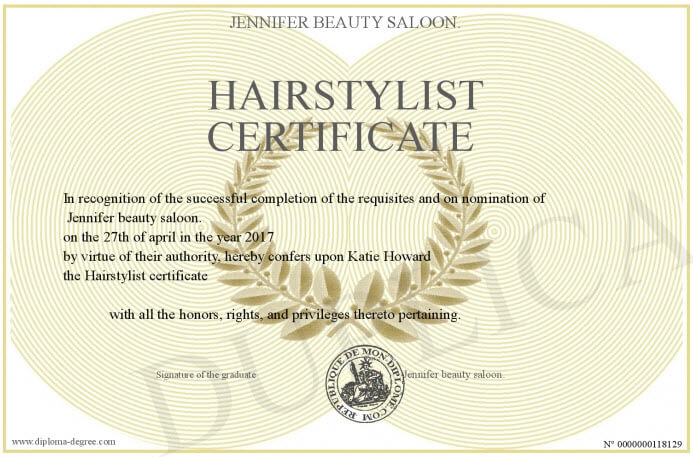Job Description: What Does a Hair Stylist Do
Hair stylists deal with a variety of different clients with wide-ranging needs.
For each client, a hairstylist will not only address their requests, but assess the health of their hair and scalp.
They will also advise clients on the best type of cut and style to suit their face shape.
A hairstylist performs a multitude of duties including: washing, conditioning, drying, coloring, bleaching, straightening, styling, and much more.
Depending on the client, they may engage in conversation while they work in order to learn more about the client.
Sometimes they get to know their clients intimately and carry on a close relationship for years.
It is imperative that every hairstylist ensure that their work area and tools are properly cleaned and sanitized between customers.
Duties
Every hair stylist is expected to perform the following duties:
- Wash hair, applying conditioner if necessary
- Dry and/or style hair according to their client’s requests
- Color hair, including highlights if desired
- Cut hair, from a simple trim to drastic changes
- Apply hair extensions
- Treat hair and scalp problems/disorders
- Apply permanents and relaxers
- Clean up and sanitize work area and tools after each client
- Be able to perform all of the above duties for children, women and men
Salary
According to the United States Bureau of Labor Statistics, the average salary for a hair stylist in 2015 was $28,770.
The actual salary earned will depend on the stylist’s years of experience, certifications, reputation, number of clients, employer, and region in which they work.
A hair stylist working in a barber shop in a small town will most likely make less money than a stylist working in an elite salon in a metropolitan area.
Hair stylists who own their own salon have the opportunity to earn more money, but must take on the responsibility of managing employees, leasing a property, and the many other tasks of a business owner.
Annually National Average Salary: $41,780
Average Annual Salary by State
| State | Avg. Annual Salary |
|---|---|
| Alabama | $35,340 |
| Alaska | $40,400 |
| Arizona | $40,680 |
| Arkansas | $32,950 |
| California | $46,600 |
| Colorado | $49,270 |
| Connecticut | $43,410 |
| Delaware | $38,890 |
| District of Columbia | $56,900 |
| Florida | $39,050 |
| Georgia | $40,500 |
| Hawaii | $41,990 |
| Idaho | $31,450 |
| Illinois | $42,120 |
| Indiana | $33,670 |
| Iowa | $44,990 |
| Kansas | $36,650 |
| Kentucky | $48,700 |
| Louisiana | $29,970 |
| Maine | $52,340 |
| Maryland | $42,490 |
| Massachusetts | $52,360 |
| Michigan | $42,340 |
| Minnesota | $40,880 |
| Mississippi | $30,130 |
| Missouri | $38,110 |
| Montana | $34,390 |
| Nebraska | $41,050 |
| Nevada | $35,990 |
| New Hampshire | $37,060 |
| New Jersey | $43,440 |
| New Mexico | $33,850 |
| New York | $41,830 |
| North Carolina | $43,130 |
| North Dakota | $40,940 |
| Ohio | $40,700 |
| Oklahoma | $36,160 |
| Oregon | $46,760 |
| Pennsylvania | $38,070 |
| Rhode Island | $35,600 |
| South Carolina | $34,210 |
| South Dakota | $40,890 |
| Tennessee | $38,630 |
| Texas | $38,050 |
| Utah | $40,820 |
| Vermont | $44,870 |
| Virginia | $47,870 |
| Washington | $62,410 |
| West Virginia | $34,590 |
| Wisconsin | $38,480 |
| Wyoming | $32,100 |
| Guam | $33,760 |
| Puerto Rico | $25,020 |
Annual Average Salary: Top 5 States
The top earning state in the field is Washington, where the average salary is $62,410.
These are the top 5 earning states in the field:
Conducted by: Bureau of Labor Statistics, Department of Labor.
* Employment conditions in your area may vary.
How to Become
Step 1Get Educated
If you’re interested in becoming a hair stylist, the first step is to enter into a training program through a community college or vocational school specializing in cosmetology.
Some technical high schools offer cosmetology programs, which is a perfect way to finish your training before you even graduate high school.
Training programs can take anywhere between six months and two years to complete, depending on the school.
The most important part of entering into a training program is to ensure that it has been approved by your state and will enable you to pass your state’s licensing exam.
Some states will accept a certain number of completed apprenticeship hours in lieu of training from a vocational school.
Requirements vary from state to state, so it is important to learn your state’s requirements before you get started.
Step 2Pass the Exam
All 50 states require hair stylists to be licensed.
After you have finished the training your state requires – which will most likely include the completion of a training program – you will need to pass an exam to get your license.
The exam will include both a written portion and may include a practical portion, which will require you to demonstrate your skills in person.
Once you pass the exam, promptly complete the necessary paperwork and submit any fees to your state licensing agency.
Step 3Seek Employment
Once you officially become a fully licensed professional hair stylist, you can start looking for a job.
Your school may offer job placement services.
The most obvious place to find work is through a salon, but you can also seek unique employment opportunities in nursing homes, spas, hotels, malls, cruise ships, and hospitals.
You can choose to be an independent contractor by renting a station or an employee earning an hourly rate and/or commissions.
About half of hair stylists are self employed.
You may also wish to start your own business, but it’s a good idea to get experience working for someone else before you go out on your own.
Classes and training in business administration will help you understand more about all the steps needed to run your own company.
Step 4Get Certified
Obtaining special certifications can help you stand out and lets you better serve your customers.
This includes classes in advanced training not included in standard hair stylist programs.
You might consider becoming an expert in subjects such as: hair extensions, hair replacement, semi-permanent straightening, hair prosthetics, or coloring.
Step 5Keep a Portfolio
When your client’s hair comes out great, take a photo!
Keep a full portfolio of all the perfect haircuts, styles, and color work you’ve completed.
Be sure to take note of any special situations that you encountered, including: fixing a bad dye job, addressing an unusual skin condition, or making a bad hair cut better.
Many stylists and salons use social media to show off their work and attract customers to their chair.
Step 6Stay Current
You will most likely have to pay a fee each year to maintain your license to be a hair stylist.
Check with your state to make sure you fulfill the requirements necessary to keep your license current so it does not become suspended.
Remember to keep learning new techniques and tools to help keep your clients satisfied and to keep your work interesting.
Education
A good background knowledge in various styling tools and techniques will provide you with all you need to know before you start serving your first clients.
In order to become a licensed hair stylist, the education requirements vary from state to state.
Not every state requires a high school diploma or GED, but most do.
Many technical high schools offer cosmetology programs, which may fulfill some or all of your state’s requirements.
Some states allow for training to be done through an apprenticeship without graduating from a vocational program.
The majority of states will require graduating from a state-approved program that will take anywhere from six months to two years to complete.
These programs are offered at vocational and community colleges or cosmetology schools.
You can also choose to obtain an associate’s or bachelor’s degree in cosmetology, which will take between two and four years.
In school, you will learn about a wide variety of important topics that you will use every day on the job.
This includes learning about: hairstyling, cutting, highlights, lowlights, perming, and relaxing hair.
You will also learn how to analyze your client’s hair so you can use and recommend the correct products.
You will also be able to spot any hair and scalp disorders that need to be addressed.
A clean, sterile environment is important, so you’ll learn how to keep your area sanitary for your clients’ health.
In addition to basic classes, it’s a good idea to take advanced classes in subjects such as applying extensions, keratin and keratase treatments, bayalage, nail care and skin care, to broaden your knowledge so you can provide additional services in the future.
In addition to practical knowledge, great hairstylists should exhibit good manual dexterity, excellent communication skills, a love of people, and the ability to understand their client’s needs while advising them of any potential problems with their requests.
Video About The Career
Certification & Licensing
After completing your training you will receive a certificate or diploma, which allows you to move forward with becoming a professional hair stylist.
Holding a license to practice as a professional hair stylist is not only required, but gives your clients the confidence in knowing that you have the proper training in your field to do a proper job.
There is often a minimum age requirement for licensure imposed by each state, which is usually between 16 and 18 years of age.
Some hair stylists receive advanced training and/or specialize in certain areas, but all are expected to be knowledgeable in subjects including: hair washing, conditioning and styling, trimming and cutting, coloring, texturing, perming, and assessing the hair and scalp for the best products and treatments.
Many of the techniques you will learn in school are important because performing them incorrectly can result in damage to your client’s hair and/or skin.
If you plan to work in more than one state, you may need to be licensed in each state.
Some states offer “reciprocity,” which means they will accept an out-of-state license to practice hair styling.
Some states group hair stylist training into a wider umbrella of cosmetology, which means that after completing the requisite training, your license allows you to also practice as an esthetician or manicurist.
The licensing exam will include a written exam, including questions about “hairstylist theory.”
You will also be given a practical exam which will require you to display your skills to a judge.
The fee to take the hair stylist exam varies, but will run approximately $100-150.
You will need to pay additional fees each time you renew your license.
Acquiring a valid license in hair styling is imperative to your success, so be sure you understand all of the conditions you will need to fulfill before you begin your journey.
There are lots of resources out there to help – talk to hairstylists you know, discuss it with your school’s guidance counselor, or contact your State’s Department of Public Health.
Certification Example:

Average Training Program Duration: 1-2 Years
Popular Programs
Job Outlook
The outlook for hair stylists in the future is good.
In 2016, there were 673,700 people employed as hairstylists, barbers, and cosmetologists, according to the United States Bureau of Labor.
About half of these individuals were self employed.
Feeling good about one’s appearance will never go out of style, so there will always be demand for hair stylists to help cut, color and design hair.
Hair stylists often have to work nights and weekends, but will probably have a say about which hours and how many hours they want to work.
About a quarter of stylists work part time.
Employment Growth Projection: 19%
2020
2030
That's a higher than average projected growth of 110,500 jobs.
Hair Stylist: Interest Over Time
Should You Become a Hair Stylist?
Overall Satisfaction: High

In just an hour or two, hair stylists can improve someone’s mood and self esteem.
By making their clients happy and seeing their creativity come to life, hair stylists often experience very high job satisfaction.
However, hair stylists do have to work long, hard hours on their feet, and be able to handle criticism and difficult clients.
There are quite a few benefits to being a hair stylist.
One of them is being able to have a flexible schedule.
Gaining a clientele of trusted customers who love your work is rewarding.
If you are a “people person” you will enjoy the new friendships you make through your work.
Average Salary: Medium

According to the United States Bureau of Labor, the average salary for a hair stylist in 2015 was $28,770.
This number also includes the average salaries for cosmetologists, so the actual average salary for hair stylists is a bit lower.
Those who are seeking higher rates of pay can look for employment in elite spas in metropolitan areas, or receive professional certifications in advanced techniques, such as applying hair extensions.
Stylists can choose to rent a station or can earn a commission through an established hair salon.
The laws on compensation can vary by state, with some states requiring a minimum hourly rate to be paid on top of commissions received.
Job Growth Outlook: High

The United States Bureau of Labor Statistics forecasts 10% in job growth for hair stylists and cosmetologists between 2014 and 2024.
However, much of one’s potential in a career as a hairstylist depends on their own ambition.
Actively seeking clients and performing your best will enable you to attract loyal clientele that will stay with you for years.
The advancement in modern techniques such as bayalage and keratin treatments keeps clients coming back to make sure their hair stays healthy and looks great.
Education Duration: 1-2 Years

The length of your education will depend on your personal path.
Some students will seek a degree in cosmetology, which will take between two to four years.
However, most hairstylists only receive about six months to two years in training.
This may be the result of a combination of in-school education and apprenticeship hours.
After you become licensed, it is wise to continue taking classes and broaden your knowledge of all the latest tips and tricks.
Additional certifications will make you a better stylist and help you command higher rates of pay.
Personal Skills Needed

Hair stylists need to have a unique set of skills and attributes to be successful at their job.
These include having:
- Good manual dexterity
- The ability to stand for long periods of time
- Good attention to detail
- The ability to keep their tools and work area clean and sanitized
- The ability to understand and deliver on each client’s requests
- The ability to assess the health of their client’s hair and scalp to provide the best care, including recommending the right products for their hair and skin type
- A friendly, personable demeanor
Frequently Asked Questions
Q. How long does it take to become a hair stylist?
Training to become a hair stylist takes between six months and two years, depending on your state’s regulations and the particular path you choose.
If you choose to earn a degree in cosmetology, this will take between two and four years.
Each state is different, and can require a certain number of apprenticeship hours to fulfill the requirements of becoming licensed.
Q. How much does a hair stylist make in a year?
The national average salary in 2015 for hair stylists and cosmetologists was $28,700, according to the U.S. Bureau of Labor Statistics.
This works out to less than $14 per hour.
Hair stylists can choose to be an employee or rent a space in an existing salong.
There are a number of unusual places to practice hair styling, such as in medical facilities, funeral homes, TV sets, hotels, malls.
One can also consider becoming an instructor in hair styling.
Salon owners can expect higher rates of pay, but will need to take on far more responsibility.
Q. What degree do you need to be a hair stylist?
You do not need a degree to be a hair stylist.
Depending on your state’s regulations, you will probably have to complete a state approved program in hair styling.
After you graduate (or receive a certificate), you will need to pass an exam to receive a license.
Some hair stylists choose to get an associate’s or bachelor’s degree in cosmetology, but this is not necessary.
Q. Do hair stylists get tipped a lot?
The average tip for a hair stylist should be 20% of the bill.
The amount of the tip will depend on the service, but it is good etiquette not to tip beneath 15%.
Stellar service will result in higher tips, so this is why it is important to always do your best to please your clients.
Many states require hair stylists to be paid a minimum hourly rate so that they do not need to rely solely on tips for their wage.
Q. What is the difference between a hair stylist and a hairdresser?
Technically, a hairdresser is responsible for washing, conditioning, cutting and coloring the hair, while a hairstylist is responsible for choosing the designs.
But realistically, the terms “hair stylist” and “hairdresser” can be used interchangeably.
There is no meaningful difference between the two titles.
A barber is responsible for shorter designs, and is generally associated with cutting boys’ and men’s hair.










I really love this but I don’t have the potential to pay my fees so that I can become one of them